Varicose veins in the legs (varicose veins - common name) - visible external enlargement of the saphenous veins, which develops as a result of varicose veins or post-thrombotic syndrome and is accompanied by a sharp violation of venous flow in the lower extremities.
Modern methods allow the treatment of varicose veins radically without incisions and pain.
Complaints about varicose veins
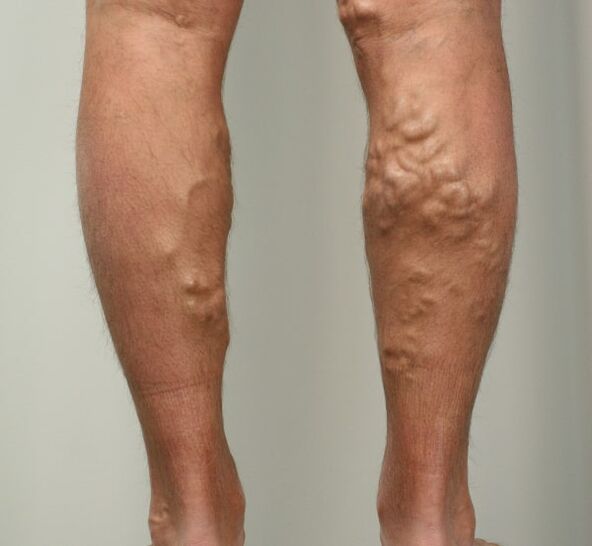
For many people, varicose veins and spider veins are just a cosmetic problem. In others, varicose veins cause pain and discomfort. Sometimes varicose veins lead to more serious problems and complications - thrombophlebitis or the appearance of trophic ulcers. Treatment consists of removing or closing the deformed veins, which is the job of a phlebologist.
Varicose veins are a complete degeneration of the venous wall, accompanied by weakening of its connective tissue (varicose veins of the lower extremities), or which develops with a sharp violation of venous flow, due to blockage or overflow of veins.
Causes of varicose veins of the lower extremities
Varicose veins of the lower extremities
The disease, as the cause of varicose veins of the legs, appears in 20-40% of the population of developed countries of the world. For a long time, varicose veins are just a cosmetic defect, but the progression of the disease leads to pain, swelling of the feet and legs, and in advanced stages to darkening of the skin of the feet, inflammatory changes and varicose trophic ulcers.
Hereditary predisposition is the main cause of veins with primary varicose veins, however, the disease develops with excessive stress in the veins. The trigger mechanism for varicose veins of the lower extremities is a sharp physical overload, pregnancy and childbirth. In this case, there is a sharp increase in pressure in the veins of the lower extremities and damage to the valve apparatus, which stimulates the mechanism of disease development.
Postthrombophlebitic disease
Secondary varicose veins develop after venous thrombosis or as a result of congenital diseases (arteriovenous fistula, congenital venous dysplasia). Post-thrombotic disease is a complex pathological process progressive in the venous system of the lower extremities. Due to valvular insufficiency or deep vein blockage, the saphenous veins dilate as they bleed. Another cause may be congenital or acquired arteriovenous fistulas. Occasionally, congenital deep vein obstruction occurs, leading to secondary varicose veins (Klippel-Trenaunay syndrome).
Complications of varicose veins
More than 40% of women and 20% of men have varicose veins. In 20% of cases, varicose veins lead to the appearance of a trophic ulcer, more than 25% of patients suffer from varicose vein thrombophlebitis. These complications often require serious treatment and pose a major health threat.
Chronic venous insufficiency
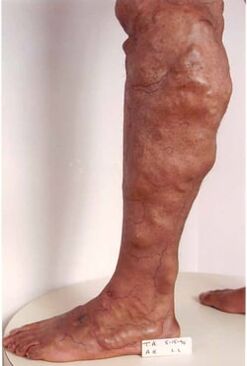
Obstruction of venous outflow causes a pathological condition called chronic venous insufficiency. From the beginning of the disease is observed the appearance of single nodes of varicose veins, which do not cause much discomfort, although sometimes they can hurt. Subsequently, there is an increase in the number of varicose veins. The disease progresses slowly but steadily. If the first varicose veins appeared below the knee, then the rate of disease development is much higher. If the disease does not stop, then gradually develops the third stage of venous insufficiency. The edema becomes permanent, a dark skin color appears in the ankle area, the aggravation in the foot is constantly disturbed, which may continue even after a night rest. Varicose vein thrombophlebitis and skin inflammation, eczema and dermatitis often develop. The final stage in the development of varicose veins is the appearance of trophic ulcers.
Varicose vein thrombophlebitis
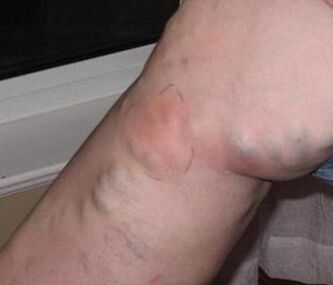
Thrombophlebitis is the most common complication of varicose veins. Thrombophlebitis is an inflammation of the venous wall, with the formation of blood clots in the lumen of the vein. Thrombophlebitis appears in superficial and deep veins. With varicose veins, thrombophlebitis occurs in 25% of patients and is usually superficial. The cause of thrombophlebitis in varicose veins is a very slow blood flow, especially in the large joints. Under these conditions, any factor that increases blood clotting (pregnancy, overheating, trauma, convulsions, hypothermia and scratching, acute respiratory infections) can cause the formation of a blood clot in varicose veins and its inflammation. Thrombophlebitis occurs in 25% of patients. with varicose veins of the lower extremities. The cause of thrombophlebitis is the slowing down of blood circulation in varicose veins. Thrombophlebitis can progress and lead to deep vein thrombosis. Chronic venous insufficiency is a painful condition of venous outflow with varicose veins. It is characterized by edema, darkening of the skin, the appearance of trophic ulcers and varicose dermatitis.
Varicose trophic ulcers
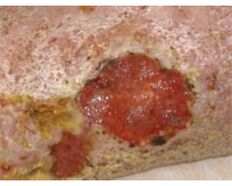
A trophic ulcer is a sign of an extreme degree of chronic venous insufficiency. This is a long-term non-healing wound that occurs with a severe violation of venous flow through deep and superficial veins. Occurs in 1% of the general population and in 20% of patients with venous disease. Every fifth patient with varicose veins who does not receive treatment sooner or later gets a trophic ulcer. It can develop with both varicose veins and secondary varicose veins. Without elimination of pathological venous discharges, a varicose trophic ulcer does not heal or recur continuously. Varicose trophic ulcers appear in most patients and cause serious suffering. Modern minimally invasive methods allow you to safely eliminate varicose trophic ulcers without incisions and pain.
Venous thrombosis and thromboembolism
Pulmonary embolism is a serious complication of venous thrombosis. Varicose veins are an important risk factor for thrombophlebitis and deep vein thrombosis. Thromboembolism leads to the development of severe heart and respiratory failure, with a mortality rate of more than 50%.
Prevention of varicose veins of the lower extremities
Every modern person needs to understand what varicose veins in the legs are, how to treat and prevent its occurrence. With an inherited predisposition, factors contributing to varicose veins should be avoided. The use of venotonic drugs, wearing compression stockings during exercise, periodic examinations by a phlebologist and ultrasound of the veins are indicated.
When working in conditions of accompanying factors, it is necessary to use first-class compression stockings at work, therapeutic exercises, outdoor activities, daily walk for at least 1 hour in medical stockings, foot massage and swimming. Refusal to use oral contraceptives with complicated inheritance of varicose veins. It is better to adhere to these simple rules than to treat varicose veins in the legs.
Avoid productive factors during heavy physical work. Compression stockings are needed for this, especially those with a predisposition to varicose veins. Medical knitwear is indicated for all pregnant women, and in cases of predisposition to varicose veins and thrombophlebitis, wear special compression stockings for childbirth. It is advisable for all pregnant women to visit the phlebologist and perform an ultrasound of the veins in the last weeks of pregnancy. This will help reduce the risk of problems with the venous system.
How to treat varicose veins in the legs
Over the past 10 years, "barbaric" methods of treating varicose veins have become a thing of the past, thanks to the emergence of the mildest and most effective methods used successfully in clinics.
Vein sclerotherapy for varicose veins
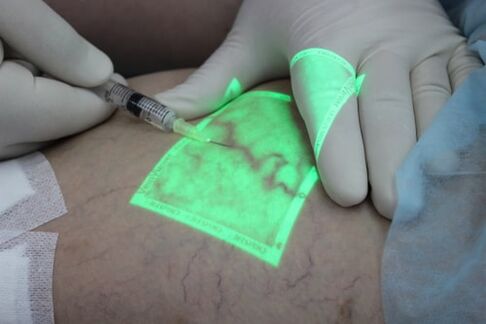
Sclerotherapy is the insertion into the lumen of a varicose vein of a medicine that causes the walls to "stick" along with the disappearance of the veins. For sclerotherapy, a variety of chemicals are used, there have been attempts to treat with ozone. At one time, the advent of foam sclerotherapy revolutionized phlebology. For the first time, an effective method for treating varicose veins without major surgery has emerged. Currently, foam sclerotherapy is used to remove varicose veins of medium diameter after laser disappearance of pathological venous discharges. Sclerotherapy is essential in the treatment of spider veins and reticular varicose veins, where there are no real competitors.
Laser treatment of varicose veins
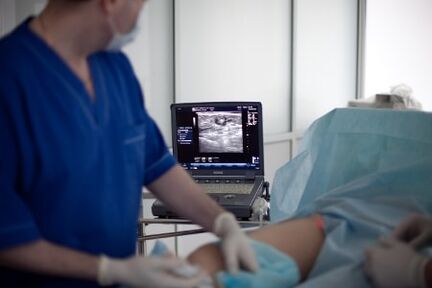
Laser treatment for varicose veins of the lower extremities (EVLT) is the most modern, radical and inexpensive method of treatment that allows you to treat varicose veins in the legs and eliminate the causes of trophic ulcer. The meaning of laser treatment lies in the thermal heating of the venous wall from within and the subsequent resorption of the varicose vein. The latest achievement in EVLT is a 1470 nm laser and a radial light guide, which have been introduced into medical practice by phlebologists. The postoperative period after this technique is completely painless, and the result is higher than other treatment options - the radicality of the laser intervention is at least 98%.
Surgery to remove varicose veins
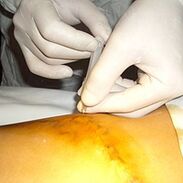
Surgical treatment of varicose veins with removal of the main venous trunks is a thing of the past. The risk of complications of source vein removal forced phlebologists to seek other approaches, which led to the development of laser techniques and other methods of thermal vein removal. However, the modification of classical phlebectomy to microflebectomy according to Müller and Varadi allowed a wonderful combination of laser treatment and removal of large varicose veins through incisions without incisions or sutures. Varad's technique saved patients from painful sclerotherapy of large varicose veins. Miniflebectomy allows you to treat varicose veins in the legs and remove visible varicose veins anywhere on the body.
Radiofrequency ablation of varicose veins
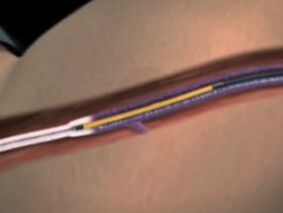
Radiofrequency (RFO) obliteration of varicose veins of the legs is a modern and safe method of treatment. The method is based on the use of microwaves that heat a metal probe, which is already the wall of the vein and causes the destruction of the inner membrane. In terms of painlessness, the method corresponds to laser coagulation with laser at a wavelength of 1470 nm, is easy to perform and has little postoperative pain. However, RFO is far inferior to laser in terms of long-term treatment results. The effectiveness of RFO is 85% without recurrence. The method is not suitable for the treatment of perforating veins.
Massage and bath for varicose veins
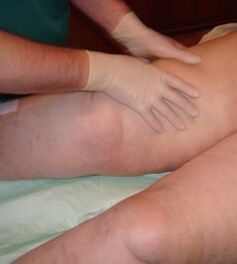
Massage is an active treatment method for varicose veins.
All kinds of modern massages are used, especially in the pathology of the lymphatic and venous system. Among the exclusive methods is the bandage lymphatic drainage massage technology, which very effectively alleviates chronic venous insufficiency.
In chronic venous insufficiency, massage is used to eliminate venous hypertension in varicose veins and post-thrombotic syndrome. The combination of this bandage massage allows you to effectively eliminate all clinical manifestations of the disease.
Bathing with varicose veins, thrombophlebitis or post-thrombotic disease is very dangerous. Any thermal stress can provoke the formation of blood clots in the deep veins with all the ensuing consequences.
Unfortunately, it is impossible to achieve a complete cure for varicose veins without eliminating venous leaks and varicose veins. Although the reduction of symptoms associated with venous blood stagnation in the legs is quite possible with the help of modern therapy. However, the prevalence of varicose veins and chronic venous insufficiency sometimes gives rise to a desire to speculate on this problem. Consider modern methods of treatment and deception.
Remedies for varicose veins
The goal of drug therapy for venous pathology is to reduce symptoms and prevent complications, but these goals are not easy to achieve. Today, the abundance of tools that can be used has brought another problem: which one to choose? Unfortunately, most of the proposed drugs have a fairly low efficacy, despite the theoretically justified suitability of use. This for a number of reasons, the main of which is the low absorption of medicinal substances of these drugs by the body. An ideal drug for the treatment of venous insufficiency should affect as many pathogenetic links of chronic venous insufficiency as possible, while having a minimal number of side effects and high absorption by the body. Quite a large number of venotonic agents are represented in the modern pharmaceutical market. However, they have similar medicinal substances (plant flavonoids) and therefore the effectiveness of one or the other depends only on the concentration and solubility of the active principle.
You should not expect the disappearance of varicose veins from these medications, however, ease of walking, a reduction of edema and the disappearance of night cramps may be.
Creams and gels for varicose veins
Despite the high efficiency promoted by retailers and manufacturers, creams and gels do not bring relief from varicose veins and varicose veins do not disappear from them. In the initial stage of venous insufficiency, phlebologists do not oppose the use of these agents, as their rubbing promotes venous flow, as a light massage, and has a calming effect on the skin. With advanced forms of venous insufficiency, these creams and ointments can cause dermatitis and allergies, and are therefore very harmful. Some medicines are used in the development of acute thrombophlebitis and help to alleviate the inflammatory process, but the varicose veins do not disappear from them. Thanks to proper advertising, shamanic products with caterpillars have gained great popularity among people, but they have no attitude towards medicines, even caterpillars, and it makes no sense to expect from them.
Medicines for blood clots in varicose veins
A common complication of varicose veins is thrombophlebitis, especially during pregnancy and the postpartum period. A proven drug for the prevention of blood clots is a low molecular weight acidic glucosaminoglycan containing sulfur. To prevent thrombophlebitis after treatment of varicose veins, tablets are used in clinics. They are taken 7 days after laser or radiofrequency intervention.
Compression stockings for varicose veins
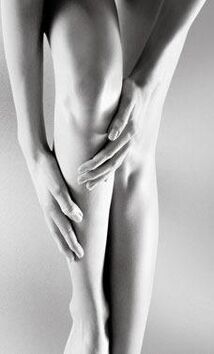
Compression stockings are undoubtedly one of the most effective tools for treating venous edema and reducing the rate of chronic venous insufficiency. Invented more than 100 years ago, gaining tremendous popularity in the 20th century and even more so in the 21st century, compression stockings and socks have become an integral part of treatment by a phlebologist. This is due to the effects it has:
- improving venous and lymphatic flow from the lower extremities,
- improving microcirculation,
- slowing the progression of the disease,
- prevention of varicose vein complications (varicothrombophlebitis, trophic disorders),
- prevention of deep vein thrombosis.
How to use compression stockings
So if you have varicose veins and plan to treat it, then during the treatment you will definitely use compression stockings for a period of a few days or a few months (individually). If your feet are swollen at the end of the day after work and you suffer from severe foot syndrome, you can also use compression stockings during the day to avoid these symptoms in the evening. If you have complications of untreated varicose veins - trophic ulcers or thrombophlebitis - you will certainly also use compression to improve the condition of the legs and reduce the unpleasant symptoms.
The fact is that by improving venous flow, compression stockings work every second of the dressing to improve the return of venous blood from the legs, which is obviously not easy for veins compromised by disease and against the law of universal gravitation. Compression knitwear can certainly be called one of the smartest inventions of humanity, but for it to work for you, some conditions must be met:
- Compression knitwear is selected individually (according to standards). The main requirement is compliance with the anatomical profile of the limbs and, consequently, the creation of the proper pressure gradient.
- Knitwear is chosen by a doctor (phlebologist) individually. Medicinal products are listed in mm Hg and are divided into compression classes 1, 2, 3, 4. Each compression class corresponds to a certain pressure. At different stages of varicose veins or chronic venous insufficiency, the appropriate compression class is used. This is why only a doctor has the right to prescribe and choose the right compression stockings - taking into account the nature of the pathology and according to individual standards.
- It should be medical knitwear, not slimming. Only proven brands with RAL certificate.
When do you need knitwear for varicose veins?
- correction of "heavy legs" syndrome: reduction of severity, edema, improvement of quality of life;
- during treatment with a phlebologist: after surgery or for a period prescribed by a specialist;
- to slow the progression of varicose veins;
- for the treatment of varicose vein complications (varicothrombophlebitis).
An essential component of any treatment for varicose veins and chronic venous insufficiency is elastic medical compression. Thanks to compression therapy, it is possible to completely eliminate swelling, aggravation in the legs and create conditions for any kind of radical treatment of varicose veins. Modern medical knitwear has a high therapeutic effect and excellent aesthetic properties.
Elastic bandages |
Therapeutic sweater |
|---|---|
The creation of the necessary pressure is determined by the technique and skills of bandaging the doctor or patient |
Treatment profile and pressure level specified during production in accordance with the compression grade |
The need for medical participation in the placement of the bandage or in the education of the patient |
Physician participation is limited to the choice of compression class and product type |
Difficulty in securing compression and fixation in the thigh |
Provides effective compression and fixation on the thighs |
Used for non-standard shapes of limbs |
With a non-standard shape of the limbs, personalization is possible |
Daily washing causes the bandages to be consumed quickly |
Daily washing is necessary to maintain the compression properties |
Must be replaced after several washes |
Guaranteed preservation of compaction properties for 6 months |
Possible violation of water balance and skin temperature |
The porous bond ensures the normal temperature and water balance of the skin |
Low aesthetic characteristics, offer comfort and convenience |
High aesthetic features, comfort and convenience in use |
Exercises and sports for varicose veins
Strength sports for varicose veins and athletics are possible after elimination of varicose syndrome, or in compression stockings of 2-3 compression classes. Modern treatment is able to return varicose legs to normal, which removes all restrictions.
We bring to your attention a complex of therapeutic and preventive exercises developed by leading experts. Its regular application will help reduce the manifestations of venous insufficiency in the lower extremities, slow the progression of the disease and reduce the risk of life-threatening complications.
- Discharge of leg veins. Breathe deeply and evenly, lie down with your eyes closed, relax. At the same time, place several pillows under your feet so that they rise at an angle of 15-20 °
- Exercise by bike. Lying on your back and breathing evenly, imagine you are pedaling a bicycle.
- The exercise consists of several parts, performed slowly and smoothly. Lying on your back with your legs outstretched, take a deep breath. Exhaling, bend the right leg, bringing the knee to the chest. As you inhale, point your foot vertically upwards. Exhaling, lower it. Repeat this exercise alternately for each leg.
- Lying on your back, arms along the body, raise your legs vertically up. Rotate both legs simultaneously from the inside, then from the outside.
- Bend and alternately bend the legs at the ankle joint back and forth.
- Bend and undress the toes alternately.
- Stand in one position: legs together, arms along the torso. Once you have taken a deep breath, rise slowly on your toes, exhaling, returning to the starting position.
- Walk in place without removing socks from the floor.
- Vertical scissors. Lying on your back, arms along the body, breathing evenly, cross your legs alternately, alternating them.
- Lying on your back, bend your knees without lifting your legs off the floor. Put your hands on your hips. By inhaling slowly, raise your head and torso. At the same time, the hands slide to the knees. Exhale slowly, return to starting position.
- Lying on your back, arms along the body, legs at an angle of 15-20 °, hold a small pillow between the legs. Inhaling slowly, bend at the waist, removing the buttocks from the mattress. Exhale slowly, return to starting position.
- Lying on your back, arms along your body, bend your knees, keeping your feet on the floor. Exhale slowly, pulling on the stomach. By inhaling slowly, inflate the stomach.
- Lying on your back, legs raised at an angle of 15-20 °. Bend the right leg, bringing the knee to the chest. At the same time, squeeze the leg firmly with your hands. Slowly steer your foot up. The hands, squeezing the leg firmly, slide along the calf to knee level. Slowly lower your leg, hands sliding over your thighs. The exercise is repeated for the other leg.
- Standing, feet together, arms along the body, inhale slowly, turn the shoulders, exhale slowly, relax the shoulders and tilt the head forward.
- Contrasting foot shower. Strong alternating hot and cold water jets. 5-10 minutes for each leg.












































